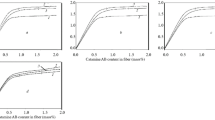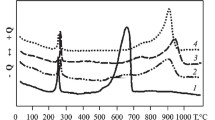Conclusions
The reasons for the resistance of the antistatic properties of polyacrylonitrile fibre, which has been modified at the gel stage with a polyethylene glycol diacrylate, to boiling washes have been investigated.
It has been suggested that the retention of the antistatic effect is caused by the manifestation of a cryptoheterogeneity effect under the washing conditions and by the possibility of migration of the antistat from the fibre pores into its surface under definite drying conditions.
Similar content being viewed by others
Literature cited
V. I. Anufrieva, N. M. Beder, et al., Khim. Volokna, No. 4, 35–36 (1981).
V. I. Anufrieva, N. M. Beder, et al., Khim. Volokna, No. 5, 40–42 (1982).
G. S. Kruglova, Vysokomol. Soed., Ser. A,17, 1541–1545 (1975).
N. M. Beder, D. M. Kabanova, and I. N. Dvoeglazova, Khim. Volokna, No. 2, 31–32 (1986).
S. S. Boyutskii, Physico-Chemical Bases of the Permeation and Impregnation of Fibrous Materials by Polymer Dispersions [in Russian], Khimiya, Leningrad (1969).
Additional information
Translated from Khimicheskie Volokna, No. 2, pp. 33–35, March–April, 1987.
Rights and permissions
About this article
Cite this article
Peskova, V.I., Beder, N.M., Glazkovskii, Y.V. et al. Reasons for the retention of long-term antistatic properties of polyacrylonitrile fibre which has been modified at the gel stage with polyethylene glycol-9 diacrylate. Fibre Chem 19, 121–124 (1987). https://doi.org/10.1007/BF00552610
Received:
Issue Date:
DOI: https://doi.org/10.1007/BF00552610




